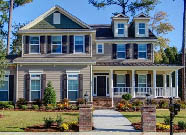Roof Inspections
Roof Inspections begins when your home inspector first arrives at the site. Before going into the house, he is likely to make a mental note of the location of dormer, chimney, and wall flashing, low pitch and flat roof surfaces, and general roof surface conditions.
What kind of roof surfacing materials are found? Asphalt strip shingles, double-coverage asphalt roll roofing, single-coverage roll roofing, built-up roofing, wood shingles, metal, fiberglass, and rubber membrane are all used in my area. The asphalt strip shingles and metal roofing are typically used on higher pitch roof surfaces. Roll roofing, built-up roofing, and membranes are generally found on lower pitch or flat roof surfaces.
Sometimes, during the inspection of the interior, your home inspector might climb out onto a low pitch roof surface from a window in order to get a closer look at the condition of the roof surfacing material.
Later on, while inspecting the exterior of the house, your home inspector might use a ladder to get a closer look at roof surfaces. Other times, he might use binoculars. Bear in mind that only an experienced home inspector should climb a ladder to inspect the roof surface. Climbing on ladders and walking on roof surfaces can be dangerous. I use a folding articulating ladder that extends to 17 feet. If the roof pitch is too steep, I do not walk on it. I do not walk on a roof with snow or ice accumulation.
The roof inspection should include an inspection of the condition of the chimneys and chimney flashing visible above the roof surface. Sometimes, your inspector will not be able to walk on the roof and will use binoculars instead.
What is the condition of the mortar and bricks? Do the top bricks look as if they are loose? Is the top of a chimney flue liner visible? Are any bricks missing? Are there multiple flues?
Since chimney flashing often leaks, many homeowners will try to seal it up with a heavy coating of black roofing cement. While this might work in the short run, a heavy coating of cement will make it necessary to replace the flashing the next time the shingles are replaced. A better way to seal the overlapping flashing layers is with a thin bead of silicone sealant that will be watertight but can easily be removed.
On the uphill side of a wide chimney, is there a cricket? A properly installed and flashed cricket can prevent water and ice from accumulating on the uphill side of the chimney and prevent leakage.
Asphalt strip shingles are available in various grades. Depending on grade, asphalt shingle service life expectancy varies between twenty and forty years. A number of factors can accelerate the aging process of asphalt shingles. For example, if a roof surface faces south, the shingles have a tendency to wear out faster. Shingles applied over well ventilated roof structures tend to last longer than shingles applied over sheathing in contact with insulation.
Here are some things your home inspector should look for on asphalt strip shingle roof surfaces. How many layers are there? I have seen as many as three! Do the shingles overhang the roof rakes by 3/8" or more or are they cut shy of the verge board trim? Is metal drip edge flashing used on the roof rakes as well as the eaves? Look closely at the roof eaves. Do the shingles extend out over the eave? Are the shingle tab edges supported by a cedar shingle starter course or metal drip edge flashing? Is the cedar shingle starter course rotten and are some of the shingle edges partly missing? Is the metal drip edge steel rather than aluminum and is it rusted? What is the condition of the shingles in the vicinity of the roof eaves? Is there any damage that could have been caused by someone breaking up an ice dam with a shovel? Are any shingle tabs missing or broken?
Check the roof valleys. Is there any accumulated debris? What is the condition of valley flashing?
In 1985 and 1986, early fiberglass reinforced shingles had a tendency to crack, especially on roof surfaces facing south. Structural shifting of the roof also causes this type of fiberglass shingle to crack. If you find out that the roof shingles were installed new in 1985 or 1986, ask your home inspector to check for cracking. If the shingles were installed over felt underlayment, the cracking should not cause leakage.
Near the seacoast, portions of asphalt strip shingles can be blown off during storms. On homes near the ocean, your home inspector is going to want to check for blow-offs.
Asphalt roll roofing is intended to last seven to ten years. It is possible to extend life expectancy by coating with roof cement or tar. This type of roofing is generally found on low pitch roof surffaces on porches and additions. Your home inspector should check for signs of aging such as cracking, blistering, delaminating seams, granule loss, and holes. The condition of wall flashing should be checked. Porch roof surfaces are subject to above average mechanical abrasion because they are often used as a work surface by paint contractors and vinyl siding installers.
Wood shingles are still used on roof surfaces. In most cases, western red cedar has the best endurance. On a wood shingle roof, your home inspector should check for rot, heavy lichen and moss, missing shingles. The condition of valley flashing should be checked.
Metal roofing should be checked for rust and corrosion as well as cracks.
An integral part of the roof inspection is the inspection of the gutter and downspout system.
With so many great reasons to work with Evans Home Inspections, why would you choose someone else?
|









